

|
Home Updates Hydros Cars Engines Contacts Links Racing ←2023 Contact On The Wire |
|
|
Oliver Monk 'Occasional Workshop Ramblings'
|
|
January 2024 The one job I donít enjoy doing is making wheels, lots of repetitive machining. I used a CNC machine shop for the last lot, but he is snowed under with work and was not interested in doing small quantities. Right: Machined blanks
|
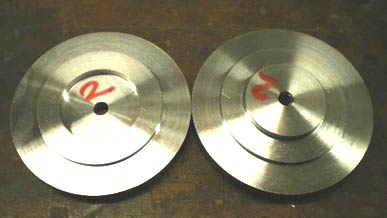 |
The rotary table was my father's, he used it when he was engraving clock dials. It's one he made from a kit, itís a bit light weight. I bought a digital rotary indexer that I fitted to the table. Itís turned out ideal for making wheels. Most tyres have a chunky bead on them that locks into to the hub, but it's not easy to cut the groove in one go on the lathe as you gets lots of chatter on the lathe tool.
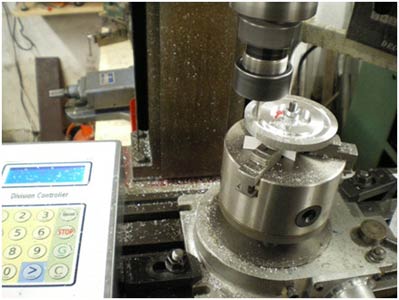 |
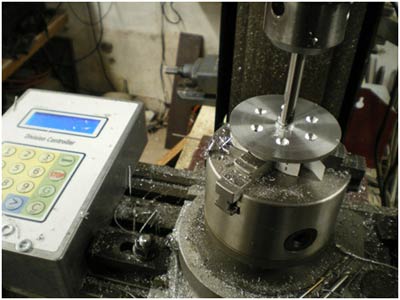 |
Milling the groove is so much easier, even more so as the digital indexer will drive the table continuously making it easy to get the depth and width correct. Drilling all the holes in the wheel is straight forward, just select how many holes then it's just a matter of pressing the button for each hole, so much easier than manually winding the table round.
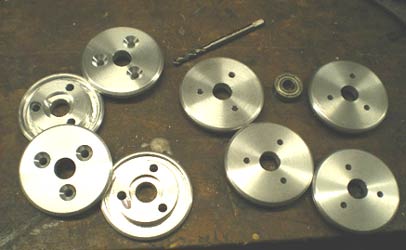 |
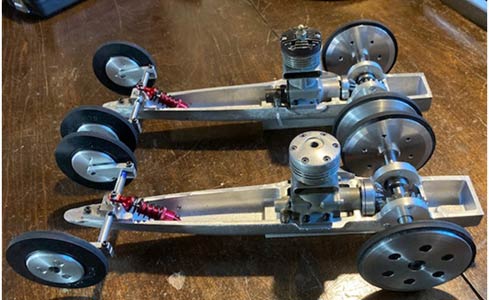 |
In total I made eight wheels for the two cars, the rear tyres are cut down, worn, modern 10cc tyres and the fronts are Moki tyres from a job lot I bought some years ago. This is where the cars are up to currently. (Upper right) Andy has both at the moment making the tops. When they are back it will be shut offs and tanks. Hopefully, they will be ready for the start of the season.
|
Last month I wrote about the flywheel for the Dooling 29 engine. I wasnít totally sure that the Loctite would hold the pinion gear in place so I have ground two small flats on the pinion gear spigot and fitted two grub screws into the flywheel, 180 degrees apart to keep it in balance. Thatís it for this month, as you know its been pretty cold. Although the workshop is insulated it is still cold in there, the tools and machines are cold to the touch so I havenít spent much time in there. The house is much warmer and we have a large kitchen table. |
|
I also fly radio control model aircraft, not very well and predominately gliders. These have all needed tlc which they have got. Aldi are currently building their largest distribution centre just outside the village, hate to think what the traffic's going to be like when it's finished.
But every cloud has a silver lining as they have given us a country park. One of the areas within the park is big enough to fly my discus launch gliders, I have flown those quite a bit this month.
Last year I turned seventy and Debby my wife bought me a English longbow making course, this was Friday evening and two full days Saturday and Sunday. It had been something I have always wanted to do. I am currently oiling the bow to seal the wood. Next month its down to the archery club to try it out and take some pictures.
February 2024
|
A very mixed bag of work this month. Drilling this 22mm hole in some aluminium bar pushed my milling machine to its limits. It tripped out three times on the way through.
Centre boss for a new 'abstellvorrichtug'. |
|
|
|
|
Made lots of swarf, drilled and tapped some big threads.
|
Here it is finished, itís a car stopper for the Buckminster track. These are used on all FEMA tracks in Europe, they are much safer than hand held brushes and much kinder to the cars.
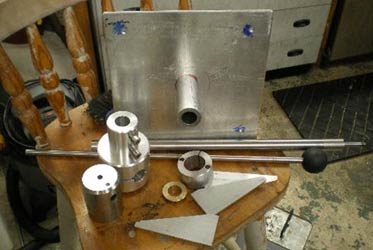 |
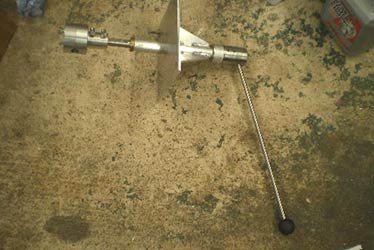 |
They use a Vileda type mop which is made from fabric and is quite soft, it is easier to control the height of the mop above the car, it should not be below the height of the bridle. A brush/mop can put a shock load onto the cable which could cause it to break if it hits the bridle.
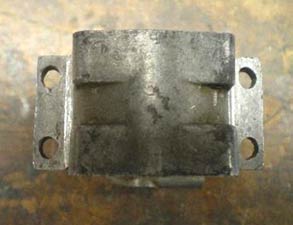 |
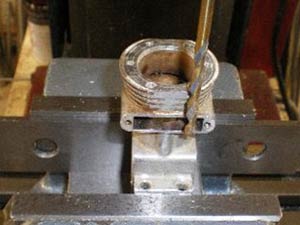 |
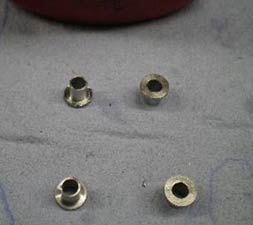 |
The is my ETA engine well used, but the latest version, the mounting holes are well over size and elongated. I have set it up in the milling machine to drill the mounting holes out oversize and back in the original locations. On the right are the 'top hats' that will go into the oversize holes and put them back to the right place and with the correct hole size. Below left is the engine in the No11 chassis
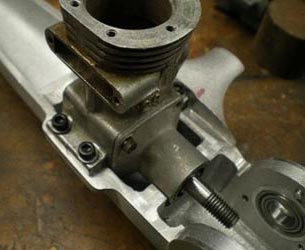 |
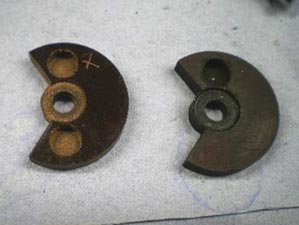 |
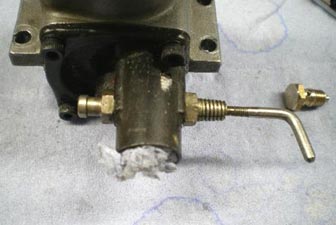 |
The timing disc on the right is well worn out, the other is one I made a long time ago on my dadís pantograph engraving machine. The right hand picture shows the standard needle assembly on the ETA, which will not be easy to connect to the tank on the No 11 car.
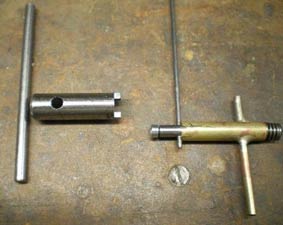 |
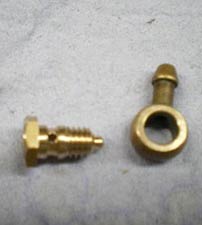 |
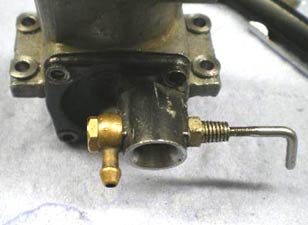 |
On the left is the tool for tightening up a special bolt on the crankshaft holding the pinion gear on, along with the shut off for the No 11 car, a simple knock off type. The banjo came out of my bits box, the other half of the valve assembly I made; this will now connect to the tank easily.
|
It's back onto modern cars as the season approaches. This picture shows a PCD insert turning tool for the high silicon content aluminium I use for making pistons, the inserts are very sharp. I have been making pistons for quite a few years now. To get the best out of an engine the liner piston fit needs to be right. Everyone has their own idea of what right is, some people like nip at the top of the stroke. The only way to measure nip easily is by liner lift. To measure liner lift, the liner and piston need to be oil free, the engine is assembled then turned over until the piston stops. Set the zero point, continue turning the engine, the liner will rise out of the crankcase until itís at TDC, measure again thatís your liner lift. During the piston making process this can controlled so that you end up with very similar fits that work in your engine. |
|
Below left is my fixture for turning the bottom of the piston so that it is square to parallel to the bottom of the piston, this will ensure the gudgeon pin is square to cylinder bore. Centre is the piston being turned to size using the PCD tool, the lubricant is honing oil. The cut is a lot less than 0.001 inches. On the right you can see the swarf floating off in the lubricant. The pistons are turned to size, no lapping.
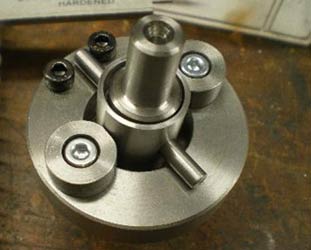 |
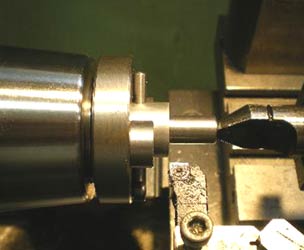 |
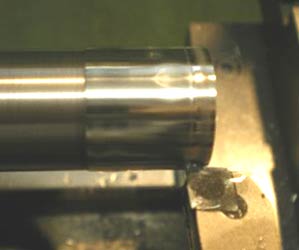 |
| Piston turning fixture | Turning base of piston | Swarf coming off the tool |
|
This is my engine assembly area. I was really struggling timing my 5cc engines, I would measure the exhaust duration get a measure of 194 degrees, measure it again with no change and get 200 degrees, it was frustrating. It turned out to be back lash between the flywheel coupling and the timing gauge. The bit of blue paper towel sticking out of the coupling solved the problem. I got both the Picco and Profi 5cc engines done with new pistons and spare liner pistons for each. As I write this the good weather has gone and the workshop too cold to make pistons. I like a nice warm constant temperate to achieve the fits I want. |
|
This month has been varied in the workshop, March will be here in a few days, pistons to do for the 2.5cc engines next. Maybe a bit of work on No11 car.
©copyrightOliverMonk2024